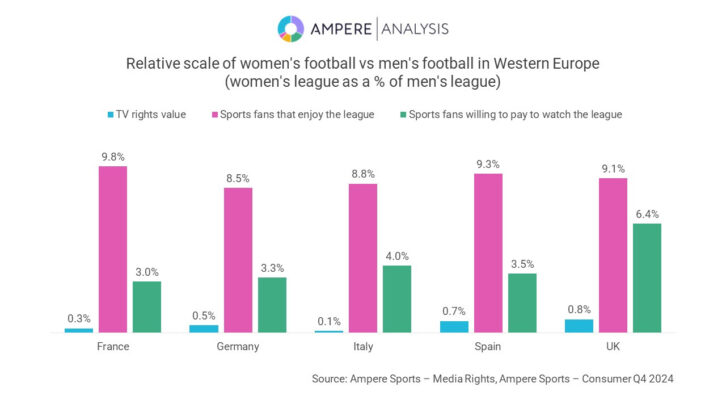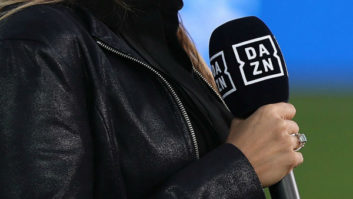Ampere Analysis has released its latest findings into European women’s leagues TV rights.

With the sport growing in popularity across the continent, the company’s research shows women’s football leagues continue to be undervalued. Currently standing at around half of the value of the men’s game, Ampere predicts the value will increase when rights are next negotiated, as growth in fans, TV audiences and willingness to pay continue to trend upwards.
Key findings include:
- The Women’s Super League (WSL) is the most valuable across the five largest European leagues, with its new deal valued at £13 million per season, around 0.8 per cent of the English Premier League contract. France’s Première Ligue is worth a reported €1.3m per season, about 0.3 per cent of the men’s Ligue 1 rights.
- Domestic fanbases for each of the women’s leagues have a much higher average value, at around 9 per cent of the men’s fanbase.
- The men’s leagues fanbases are typically more engaged, with a higher number stating they watch most or all of the competition.
- Although a higher proportion (between 19 and 41 per cent) of men’s supporters are willing to pay to watch than women’s (1 to 3 per cent), the willing-to-pay fanbase for women’s leagues is still 3 to 6 per cent the size of that for the men’s leagues. Analysts believe this indicates there is an opportunity for women’s TV rights to grow further.
Danni Moore, senior analyst at Ampere Analysis, said, “Although followers of the women’s leagues are less engaged with live coverage, and willingness to pay for the women’s leagues may be low, the gap between the women’s and men’s fan bases and TV audiences is not as extreme as media rights values imply. Ampere’s analysis indicates that the recent scaling of women’s fan bases should drive upside for rights owners in the next round of negotiations. Growing audiences and increasing willingness to pay for access among supporters are likely to support increased deal values in the future, closing the gap a little between the men’s and women’s games. The lack of historic precedent, however, means that women’s competitions will have to work hard to prove this value to prospective rights buyers. They will also have to continue to balance how they prioritise the benefits of the greater reach afforded by free-to-air coverage versus the opportunity to support higher fees through subscription-only access.”







